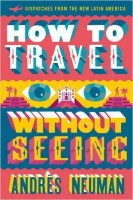How to Travel Without Seeing: Dispatches from the New Latin America
by Andrés Neuman
(Restless Books, £12.99)
 Andrés Neuman travelled through 19 countries one after the other. He had little trouble with immigration officers, but he did arouse the suspicions of a parking attendant. That was in San José, Costa Rica, where the attendant saw him scribbling note after note on the street and thought he must be writing tickets.
Andrés Neuman travelled through 19 countries one after the other. He had little trouble with immigration officers, but he did arouse the suspicions of a parking attendant. That was in San José, Costa Rica, where the attendant saw him scribbling note after note on the street and thought he must be writing tickets.
He was writing this book — on the spot, if his introduction can be believed. A tour he was sent on after winning a literary prize had him pinballing from place to place, so the writing, he decided, should reflect that; the journal should take on the form of the journey. The result is not so much a travel book as a travelling one: instant, impressionistic, written from a need “to trap small realities on the go and interpret them in real time”.
Real time, in this case, was from the end of June 2009, when Latin America in general was preoccupied with an epidemic of swine flu and Honduras was dealing with the fallout from a coup. The latter event prevented Neuman from writing about that country at first hand, but otherwise little seems to have escaped his notice.
His preoccupation with dealing with whatever is right in front of him, right now, doesn’t preclude him from looking beyond it; from exploring questions of nationality and identity, immigration and globalisation; from reflecting on both politics and plastic surgery. In Venezuela, he observes, “you cannot not talk about Chávez. That is perhaps his main victory and his greatest act of oppression.” In Puerto Rico, a US territory, he notes “An accent with curves. Overflowing and self-fulfilling legs and butts, flaunting the insulting independence that this island will never have.”
Neuman, who was born in Argentina, grew up in Spain and describes himself as a “partial Andalusian”, set off on his travels after his novel Traveller of the Century won him the Alfagura Prize and was shortlisted for the IMPAC Dublin Literary Award. If this isn’t an account of a book tour — there’s nothing about talks, interviews or signings — it’s certainly a bookish one, with constant references to the works of other Latin American writers and of film-makers, both established and up-and-coming, and the light they shed on the region. Students — and even teachers — of Latin American Studies could read it with pleasure and profit. So too could anyone who is keen to visit the region — whether on a plane or in an armchair.
Neuman can pin down a place in a sentence or two. Of the Bolivian capital, La Paz, he writes: “I contemplate the brick constructions attached to the mountains, ascending organically. These orange dwellings expand, snake and morph as the family gets bigger. First a room, then a patio. Later a second bedroom. They are genealogical houses, casually remodelled, as mutable as the sky that covers them.”
In Miami he notes: “A diffused throbbing sensuality. A chromatic elasticity in the skin. A trace of the gym in every navel. Cars, sandals, money.” And in another entry: “Miami, melting pot or collection of ghettos? In all honesty, here the mixture of cultures only occurs among people of a single colour: dollar-green.”
The book was first published, in Spanish, in 2010. It’s a shame that it’s taken so long for an English-language edition to appear, for its immediacy, its feeling of being up-to-the-minute, is diminished by references to events that are now more properly history than current affairs. But then an account of Neuman’s trip that was truly in tune with contemporary travel would, of course, not be a book at all but a blog. Or maybe even a Twitter feed. MK
A shorter version of this review appeared in The Daily Telegraph

Leave a Reply